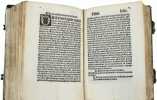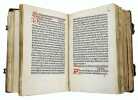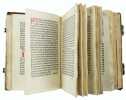THOMAS A KEMPIS
Imitatio Christi.
Brescia, Jacobus Britannicus, 1485.
Reference : 17918
"Celui qui me suit ne marche pas dans les ténèbres". Ainsi commence le "De imitatione Christi", rédigé à la fin du XIVe siècle ou au début du XVe siècle. C'est " l'un des plus grands succès de librairie que l'Europe ait connu de la fin du Moyen Age au début de l'ère contemporaine." (Yann Sordet). Jolie édition en caractères romains, donnée par Jacobus Britannicus qui acheva d'imprimer son premier livre à Brescia le 7 Mai 1485. Celui-ci, datant du 6 Juin semble être son troisième livre. L' Imitatio Christi est attribué dans cette édition à Saint-Bernard. Grandes initiales peintes en rouge et titre de paragraphe souligné en rouge, petites initiales rehaussées en jaune. Il manque le premier feuillet A1 qui est blanc et le feuillet n2. Petite restauration feuillet m1. Colophon: Impressum Brixiæ per Jacobum Britannicum Brixianum di sexto Junii Mcccclxxxv. BMC VII974. ISTCii00009000. GW M46732. Relié à la suite : CLIMAX, Johannes. [Scala paradisi]. (Paris), Denis Roce, (vers 1505). In-8 de 158 ff. Une rare édition, classée parmi les incunables par certains bibliographes, mais que la BNF date autour de 1505. L'Echelle du paradis est un traité d'ascétisme monastique rédigé vers 600. Caractères gothiques. Initiales criblées rehaussées en jaune. Grande marque de limprimeur Denis Roce avec sa devise "A laventure tout vient à point qui peut attendre". Le livre a été imprimé par Jean Barbier, André Bocard ou Gaspard Philippe, d'après le matériel typographique. Colophon : "Finis tricesimi gradus huis celestis scale doctoris spûalis johannis scolastici abbatis montis sinay: qui ab edito libro cognominatus est Clymacus idest scalaris." Signatures: a-s8, t10. La marge supérieure du titre a été découpée sur 1 cm sans atteinte au texte. Un manque sans atteinte dans la marge du feuillet cxxxix. Brigitte Moreau I, 119. ISTC ij00311000. BMC VIII 229 (date around 1499). GW M13402. Goff J311. Une fente dans le haut et le bas de la première charnière. Les liens d'attaches manquent. Les plats de la reliure sont ornés de filets d'encadrement, avec quatre fleurons portant chacun le symbole des évangélistes. Bel exemplaire dans une très intéressante reliure. /// In-8 de (118) ff. Vélin sur ais de bois, décor estampé sur les plats, dos à trois nerfs. (Reliure de l'époque.) //// "Whoever follows me will never walk in darkness". Thus begins the "De imitatione Christi", written at the end of the 14th century or the beginning of the 15th century. It is "one of the greatest successes of bookselling that Europe knew from the end of the Middle Ages to the beginning of the contemporary era." (Yann Sordet). Nice edition in Roman type, given by Jacobus Britannicus who completed the printing of his first book in Brescia on May 7, 1485. This one, dated June 6, is apparently his third book. The Imitatio Christi is attributed in this edition to Saint Bernard. Large initials painted in red and paragraph title underlined in red, small initials highlighted in yellow. The first leaf A1 is missing, which is blank, and leaf n2. Small restoration of leaf m1. Colophon: Impressum Brixiæ per Jacobum Britannicum Brixianum di sexto Junii Mcccclxxxv. BMC VII 974. ISTC ii00009000. GW M46732. Bound after : CLIMAX, Johannes. [Scala paradisi]. (Paris), Denis Roce, (ca. 1505). In-8. 158 ff. A rare edition, listed among the incunabula by some bibliographers, but which the BNF dates around 1505. The Ladder of Paradise is a treatise on monastic asceticism written around 600. Gothic characters. Cribbed initials highlighted in yellow. Large printer mark of Denis Roce with his motto "A l'aventure tout vient à point qui peut attendre". The book was printed by Jean Barbier, André Bocard or Gaspard Philippe, according to the typographic material. Colophon: "Finis tricesimi gradus huis celestis scale doctoris spûalis johannis scolastici abbatis montis sinay: qui ab edito libro cognominatus est Clymacus idest scalaris." Signatures: a-s8, t10. The upper margin of the title has been trimmed for 1 cm without affecting the text. A gap without lost of printed material in the margin of folio cxxxix. Brigitte Moreau I, 119. ISTC ij00311000. BMC VIII 229 (date aroud 1499). GW M13402. Goff J311. A crack in the top and bottom of the first hinge. The binding ties are missing. The boards of the binding are decorated with filleted borders, with four fleurons each bearing the symbol of the evangelists. Beautiful copy in a very interesting binding.
Bookseller's contact details
Hugues de Latude
Hugues de Latude
06 09 57 17 07
Payment mode



Sale conditions
Books are guaranteed to be complete and in good condition unless otherwise stated.
4 book(s) with the same title
Imitatio Christi.
Paris, Philippe Pigouchet, 1492.
"Celui qui me suit ne marche pas dans les ténèbres". Ainsi commence le "De imitatione Christi", rédigé à la fin du XIVe siècle ou au début du XVe siècle. C'est " l'un des plus grands succès de librairie que l'Europe ait connu de la fin du Moyen Age au début de l'ère contemporaine." (Yann Sordet). Edition avec le "De meditatione cordis" de Jean Gerson. Achevé d'imprimer le 15 Juillet 1492, quelques semaines avant que Christophe Colomb ne s'embarque pour sa découverte de l'Amérique. Edition rare. Philippe Pigouchet a été un excellent imprimeur de la période incunable. Il a exercé sont art de 1488 à 1518, et imprima près de 150 livres, dont 90 éditions différentes de livres d'heures. Large initiale peinte en bleue et rouge en début de texte, toutes les initiales ont été peintes en début de chapitre. Le feuillet A1 qui porte seulement la marque de Philippe Pigouchet au recto, et dont le verso est blanc, manque ici et il a été remplacé par une page de titre avec un bois gravé d'une autre édition de l' Imitatio Christi. Bel exemplaire qu'un grand bibliophile du XIXe siècle a fait relié par Bauzonnet-Purgold vers 1820. /// In-8 gothique de (96) ff., [am8]. Maroquin violet, dos à nerfs orné, large encadrements dorés sur les plats, tranches dorées. (Reliure du XIXe.) //// "Whoever follows me will never walk in darkness" Thus begins the "De imitatione Christi", written at the end of the 14th century or the beginning of the 15th century. It is "one of the greatest successes of bookselling that Europe knew from the end of the Middle Ages to the beginning of the contemporary era." (Yann Sordet). Edition with the "De meditatione cordis" of Jean Gerson. Printed on July 15, 1492, a few weeks before Christopher Columbus embarked for his discovery of America. Rare edition. Philippe Pigouchet was an outstanding printer of the incunabula period. He practiced his art from 1488 to 1518, and printed nearly 150 books, including 90 different editions of books of hours. Large initial painted in blue and red at the beginning of the text, all initials were painted at the top of chapters. The leaf A1 which bears only the trademark of Philippe Pigouchet on the recto, and whose verso is blank, is missing here and has been substituted by a title page with a woodcut of another edition of the Imitatio Christi. A very fine copy bound by Bauzonnet-Purgold around 1820 for a great 19th century bibliophile. No copy in Great-Britain. GW M46796. ISTC ii00025000.
Welche Mystiker haben den Verfasser der Imitatio Christi beeinflusst ?
Sendenhorst, Drukk. Von F. Pöttken 1926 x + 37pp., 22cm., Doctoral Dissertation ("Inaugural-Dissertation zur Erlangung der theologischen Doktorwürde bei der Hochwürdigen Theologischen Fakultät der Westfälischen Wilhelms-Universität zu Münster i.Westf."), R117496
Prolegomena zu einer neuen Ausgabe der Imitatio Christi nach dem Autograph des Thomas von Kempen. Zugleich eine Einführung in sämmtlichen Schriften des Thomas, sowie ein Versuch zu endgültiger Feststellung der Thatsache, dass Thomas der Verfasser der Imitatio ist. Erster Band - ( Zweiter Band). 2 vols.
"6. Berlin, C.G. Lüderitz'sche Verlagsbuchhandlung, Carl Habel, 1873- 1883, 2 vols in-8°, xliii pp + 522 pp ; lxxxii pp + 544 pp + 15 photolithographic plates, bound in uniform green half morocco, raised gilt spine, marbled boards and endpapers, ex-library with some small stamps, but still a fine copy."
Untersuchungen über Buch II und III der 'Imitatio Christi'
Amsterdam, Noord-Hollandsche Uitgevers-maatschappij 1955 154pp., in the series: "Verhandelingen der Koninklijke Akademie van Wetenschappen te Amsterdam. Afdeeling Letterkunde" Nieuwe reeks dl.XXXIV, text in german, some foxing on edges, else VG
 Write to the booksellers
Write to the booksellers













